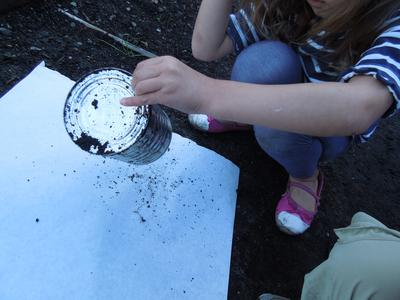Pitfall Trap
Do you have a pest problem in your garden or just want to find out what visits after hours? In this case children planted kale and lettuce seeds that began germinating and then disappeared. We knew something must be eating them. A biologist recommended using a pitfall trap to catch small animals that come in the night.
A piece of butcher paper is used to keep a running tally of animal finds.
materials
Broom or Soft Brush
Field Guides and Other Nature Books
Paper
Plywood
Push Pins
Recycled Container (e.g. 1 Quart Yogurt Container or Coffee Can)
Ruler
Sharpies
Shovel
methods
Five-year-olds dump the contents of the container onto the butcher paper themselves.
Explain that we are going to try and find out what might be eating our seedlings at night when we are not in the garden.
Explain that a pitfall trap can be placed in the ground so that animals can walk inside of it when they are out at night and won't be able to escape.
Have the children dig a hole deep enough for the recycled container to be placed inside with the top edge flush with ground level. It is helpful to place the lid back on the container for the backfilling process as dirt is brought back up to the level of the top of the container. The lid can then be left off. Two-year-old children were able to work together and complete this part of the project independently once it was explained to them.
Each day for a week have children tap out the container onto a piece of butcher paper and keep a running tally of the animals found inside. In our case we found all arthropods: spiders, crustaceans (roly polies), insects (spring tails, earwigs, and unidentified, tiny, winged insects), and millipedes. Use a different color of Sharpie to indicate each type of animal found, aiding in classification of types of arthropods. Tallying gives an example of a fast way to count and introduces sets of numbers.
We later realized that we weren't capturing certain animals: salamanders, earthworms, slugs, and snails were all possibilities. After one week of capturing animals in the pitfall trap (43 in total) we switched to a cover board, which is placed atop the soil and animals are counted each morning. We removed all the animals we found by letting them crawl away, picking them up, or brushing off the board so we could start anew each day.
The tallied large sheets of butcher paper began fading as we were still researching whether animals were pests, so we decided to make a graph of the information as another way to show data. I explained the process of dividing the paper into different columns to designate animal families and different rows to designate species within those families, then finding out how many squares we would have to draw to represent the maximum number of animals found. It was up to the children to color in the squares.
Children independently found earwig information in a book.
Children are intensely interested in the tiny animals.
Notes
For older children it may be a good idea to have a graph drawn or painted on the cover board. Since the animals run quickly it may be simpler to count them (as well as more accurate) if children are assigned individual squares.
Children make our chosen cover board safe for all by removing industrial staples primarily through the use of pliers and screwdrivers. It's a piece of plywood reclaimed from a nearby warehouse.
Using a broom to dust off the day's springtail population after counting.
Examining and identifying animals.
Browsing Bugs of Northern California for earwig information.
Spontaneously working on their own research.
Making a graph on an a donated hanging file folder.
Graphing data.
Copying vocabulary and data styles: tally, data, graph.
Results are "published" on our outdoor bulletin board. We added dots next to each type of animal to indicate how it impacted the garden's health:
Red = Bad
Yellow = Some Benefits, Some Harm
Green = Good
And there was a special note for one particular classroom thanking them for their work... About five months worth!
Lesson plan by Heather Taylor, teachoutside@gmail.com. You are welcome to share all materials with credit to her.














